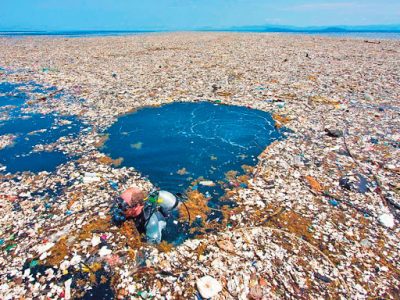Can Polymateria stop the tide of plastic waste? - Dispatch Weekly
December 2, 2020 - Reading time: 10 minutes

A “self-destructive” plastic has helped define a new British standard for biodegradability. What we mean by this: a self-damaging plastic that, according to researchers at Bristol University, is helping to define the new “British standard” for biological degeneration.
In the North Pacific lies a huge amount of floating debris, the so-called Great Pacific Garbage Patch. It is estimated that land, including man-made mountains, accounts for about one-third of all plastic waste in the world.
A group of environmentalists has filed a petition with the United Nations to recognize the island as an official nation. Officially, other nations are obliged to dispose of the rubbish on the islands, but not the rest of the world.
But cleaning up is only part of the problem, and the biggest is material as stubborn as plastic. These include toxic chemicals, pesticides and toxic metals, as well as human waste.
One solution would be a type of plastic that would be biodegradable – this means a piece of plastic would be washed away in a river or ocean and turned into many smaller fragments. That is the ambition that drives a British company called Polymateria and it is one of the most promising solutions to the problem of pollution in the world.
During production, an additive is mixed into normal plastic to produce a harmless wax that decomposes in the presence of water and carbon dioxide and shrinks into smaller fragments that can be recycled in a normal way. Bacteria and fungi digest the wax and split it into carbon dioxide and water along with other microbes.
If the technology is brought to market and is being tested in a handful of countries, including the UK, it could change the way it is produced, Polymateria says.
A comprehensive review of plastic production in 2016 found that of the 8.3 billion tonnes of plastic ever produced, 6.3 billion were turned into plastic waste and only nine per cent were recycled. According to a World Bank report, the number of polyolefins in the global food supply and consumer goods will continue to increase until 2016.
Plastic is the most polluter in the world, “Dunne told Britain’s National Geographic magazine in a recent interview with the magazine’s editor-in-chief, Dr. Michael O’Neill.
It is planned to set a recycling date for each piece of plastic, but consumers will first be encouraged to recycle products made from modified polyolefins. When the packaging ends up as waste, it is not biodegraded as it is exposed to the elements. In laboratory tests that mimic the real-world conditions, polypropylene grows from the environment and returns to nature, and polyethene has also grown back into nature, “Dunne explained.
Auto-destructing Plastic
Polymateria has developed a rigorous testing standard for biotransformation processes and has a laboratory at the School of Biological Sciences at the University of Bristol in the UK Department of Chemistry and Biotechnology.
The plan is that the material remains stable and then, when exposed to elements, triggers its own decomposition. A machine called a weatherometer is used to measure the controlled weathering of the plastic under the influence of light, humidity and temperature. The number of special additives could be increased or reduced depending on the duration of the biodegradation phase.
However, this is difficult due to the complexity of biodegradation and the different types of material such as polyethylene.

“Given the enormous value of this new technology for polymaterials, we are keen to keep the exact details under wraps, but we will find out that the main additives contain dozens of different components, including oil, rubber and desiccant.” says Dunne.
As soon as the additive is exposed to the elements, it triggers the link in the polymer chain that cuts itself, creating a small chemical compound. Light, air and moisture act against the plastic, so that it becomes a wax which is then digested by bacteria and fungi. Ecotoxicity tests have classified the resulting wax as either non-biodegradable or toxic to humans, animals and plants. To confirm the findings of the BSI-backed technical group, independent laboratories in Florida and Scotland developed indoor and outdoor weather cycles.
Polymateria stresses that its addition had no negative impact on the recycling flow. However, the company stresses that the decomposition process only applies to those who escape the normal recycling process.
Indeed, Asia, where many countries are struggling with plastic waste, is the region they are mostly targeting. Polymateria is in the process of manufacturing these pellets for use in a number of countries in Asia and Africa, as well as the Middle East and North Africa.
In 2016, materials scientist Dr David Lee, professor of biochemistry and biophysics at Cambridge University told National Geographic: “Biotransformation is one of the most promising areas of research in the field of biofuels, biotechnology and biotechnology. The Eureka moment was the discovery of an iterative process, which is an ‘iterative’ process and leads to the creation of a new type of plastic.”
Wallis from Polymateria believes his company is the only one on the planet that has proven technology to biodegrade a type of polyolefin plastic. No other technology is known And I don’t think anyone has gone through a standardized test or the umpteenth degree of validation, “he said.
The company’s marketing material claims even more: it is the only plastic material that is truly biodegradable and “the only one of its kind in the world.
The standard’s landscape has changed over the years as living things themselves have changed and its standards have been updated to reflect the growing science and the standard’s increasing relevance to the real environment, citing the impact of climate change on the environment, as well as the effects of global warming and the rise of fossil fuels.

Into the real world
Polymateria already mixes its additives into plastics used in several countries around the world for certain commercial food packaging, Dunne added. The company did not say what product brands are available, but said there are “a number of brands in the market with a wide range of applications in food and beverage packaging.” It has been tested in India and is in talks with manufacturers in China and the US, and soon it will be tested in other countries such as Australia, New Zealand and South Africa.
Dunne is convinced that his material will have a positive impact on the quality of food and beverage packaging and animal health.
I think most people will do the right thing but I’m not sure I do and the jungle of eco-labels that packaging creates has left me incredibly confused, “he adds. He says it will help to counter the “greenwashing” found in other packaging to be environmentally conscious. I believe that the claims do not always do justice to what they say, and so the ‘eco-labels of the jungle’ that have been created for packaging leave me extremely confused.
This claim is backed up by solid scientific evidence, which is not the case at present, as the system has failed and biodegradation is needed. It sets out a clear timeframe within which responsible disposal must take place and provides for the technology to be used in the future.

DW Staff
David Lintott is the Editor-in-Chief, leading our team of talented freelance journalists. He specializes in covering culture, sport, and society. Originally from the decaying seaside town of Eastbourne, he attributes his insightful world-weariness to his roots in this unique setting.




